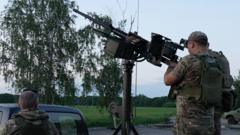Ukrainian forces adapt fishing nets to intercept Russian drones, highlighting a resourceful approach to combatting high-tech threats.
Ukraine Utilizes Fishing Nets as Drone Defense on the Eastern Front

Ukraine Utilizes Fishing Nets as Drone Defense on the Eastern Front
Innovative low-tech solutions demonstrate resilience in the face of advanced warfare strategies.
In a surprising twist in modern warfare, Ukrainian troops have turned to a humble yet effective tool in their battle against advanced Russian drones: fishing nets. These nets are not meant for catching fish but are strategically deployed along key routes and military checkpoints in Ukraine’s eastern front to ensnare and immobilize the enemy’s unmanned aerial vehicles (UAVs).
With the ongoing drone onslaught from Russia, which has increasingly utilized advanced models capable of bypassing electronic jamming, Ukraine faces a growing challenge. These drones are agile, able to penetrate deep into Ukrainian territory to strike at vulnerable logistical targets. In response, Ukrainian military engineers have rallied around the idea that traditional fishing nets can serve a new and critical function—they can tangle the propellers of these high-speed drones, effectively neutralizing their threat.
Many of these nets are sourced from donations by Nordic fishermen or are constructed in areas away from combat, showing a collaborative effort to repurpose available resources for immediate military needs. Lt. Col. Maksym Kravchuk, chief of communications for the Ukrainian Army's engineering forces, has noted the growing implementation of these nets. "Military engineers observed that even an ordinary fishing net could stop or damage an enemy drone," he stated, emphasizing that nets are now being installed across the entire front line, from the eastern onwards.
As armed conflict continues to evolve, this innovative use of low-tech solutions against sophisticated threats underscores the importance of adaptability and resourcefulness in modern warfare. Utilizing what is readily available, Ukraine demonstrates that sometimes the simplest methods can be the most effective in turning the tide of battle.
With the ongoing drone onslaught from Russia, which has increasingly utilized advanced models capable of bypassing electronic jamming, Ukraine faces a growing challenge. These drones are agile, able to penetrate deep into Ukrainian territory to strike at vulnerable logistical targets. In response, Ukrainian military engineers have rallied around the idea that traditional fishing nets can serve a new and critical function—they can tangle the propellers of these high-speed drones, effectively neutralizing their threat.
Many of these nets are sourced from donations by Nordic fishermen or are constructed in areas away from combat, showing a collaborative effort to repurpose available resources for immediate military needs. Lt. Col. Maksym Kravchuk, chief of communications for the Ukrainian Army's engineering forces, has noted the growing implementation of these nets. "Military engineers observed that even an ordinary fishing net could stop or damage an enemy drone," he stated, emphasizing that nets are now being installed across the entire front line, from the eastern onwards.
As armed conflict continues to evolve, this innovative use of low-tech solutions against sophisticated threats underscores the importance of adaptability and resourcefulness in modern warfare. Utilizing what is readily available, Ukraine demonstrates that sometimes the simplest methods can be the most effective in turning the tide of battle.




















